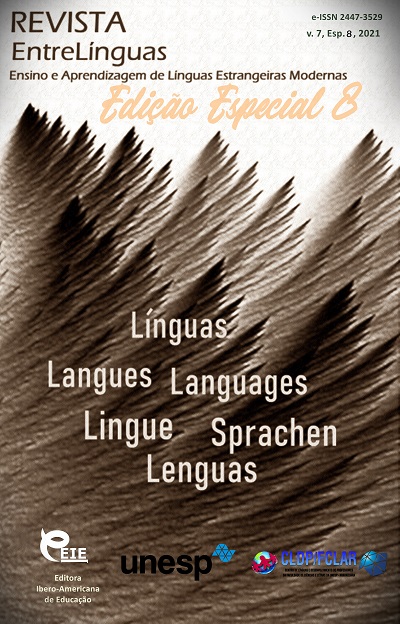"Natureza humana": fenomenologia vs naturalismo
DOI:
https://doi.org/10.29051/el.v7iesp.8.16348Palavras-chave:
Natureza humana, Ciências cognitivas, Fenomenologia, Naturalismo, EnativismoResumo
O artigo sistematiza o conhecimento filosófico da natureza humana do ponto de vista de duas posições metodológicas tradicionalmente mutuamente excludentes: de um lado, as ciências cognitivas, que buscam objetivar o mundo e a essência do homem neste mundo; por outro lado, um discurso fenomenológico que eleva a experiência subjetiva da existência humana ao absoluto e, por conseqüência, à essência ontológica do homem. Verifica-se que a insuficiência de cada uma das abordagens metodológicas descritas de forma bastante orgânica levou a teoria social à sua colaboração - o surgimento do enativismo. Esta abordagem da definição da natureza humana revela-se mais completa, pois combina as duas imagens do mundo - fenomenológica e científica. O artigo também traça a conexão teórica e lógica entre o enativismo e as atitudes ideológicas dos ensinamentos religiosos indianos. Os autores descobrem essa conexão analisando aspectos da metodologia como a ontologia, o processo de cognição, a maneira de perceber a realidade, etc.
Downloads
Referências
МЕРКУЛОВ, И.П. (2009). Меркулов И. П. Когнитивная Наука [Электронный ресурс]. Энциклопедия эпистемологии и философии науки / Составление и общая редакция. И. Т. Касавин. – М.: «Канон+» РООИ «Реабилитация»,. – С. 364-365. – URL: https://gufo.me/dict/epistemology_encyclopedia/когнитивная_наука (дата обращения: 17.06.2020).
MILLER, GEORGE A. (2003). The cognitive revolution: A historical perspective. Trends in Cognitive Sciences, 7(3), 141–144.
TENGELYI, L. (2013). Agonistic World Projects: Transcendentalism Versus Naturalism. The Journal of Speculative Philosophy, 27(3), 247–249.
VARELA, F.J., THOMPSON, Е., & ROSCH, Е. (1991). The embodied mind: Cognitive science and human experience. Cambridge, MA: MIT Press, – 321 p.
GIBSON, J.J. (1979). The Ecological Approach to Visual Perception. Boston: Houghton Mifflin. ISBN 0898599598 (1986).
NEISSER, U. (1976). Cognition and reality: Principles and implications of cognitive psychology. New York: Freeman. ISBN 978-0716704775
КНЯЗЕВА, Е.Н. (2006). Эпистемологический конструктивизм. Философия науки. – М.: ИФ РАН, Выпуск 12. Феномен сознания. – С. 156.
ЛЫСЕНКО, В.Г., ТЕРЕНТЬЕВ, А.А., ШОХИН, В.К. (1994). Ранняя буддийская философия. Философия джайнизма. / В. Г. Лысенко,. – М.: Вост. литература, – С. 242.
КНЯЗЕВА, Е.Н. (2014). Энактивизм: новая форма конструктивизма в эпистемлогии.– М.; СПб.; Центр гуманитарных инициатив, Университетская книга, – С. 163.
МЕСЯЦ, С.В. (2012). Иоган Вольфганг Гёте и его учение о цвете (часть первая). М.: Кругъ, – С. 21.
Downloads
Publicado
Como Citar
Edição
Seção
Licença

Este trabalho está licenciado sob uma licença Creative Commons Attribution-NonCommercial-ShareAlike 4.0 International License.
Os manuscritos aceitos e publicados são de propriedade da Revista EntreLínguas. Os artigos publicados e as referências citadas na Revista EntreLínguas são de inteira responsabilidade de seus autores.
Transferência de direitos autorais – autorização para publicação
Caso o artigo submetido seja aprovado para publicação, já fica acordado que o(s) autor(es) autoriza(m) a UNESP a reproduzi-lo e publicá-lo na EntreLínguas, entendendo-se os termos “reprodução” e “publicação” conforme definição respectivamente dos incisos VI e I do artigo 5° da Lei 9610/98. O artigo poderá ser acessado pela rede mundial de computadores (Internet), sendo permitidas, a título gratuito, a consulta e a reprodução de exemplar do artigo para uso próprio de quem a consulta, desde que haja a citação ao texto consultado. Essa autorização de publicação 328 EntreLínguas, Araraquara, v. 1, n .2, p. 323-328, jul./dez. 2015 não tem limitação de tempo, ficando a UNESP responsável pela manutenção da identificação do(s) autor(es) do artigo. Os artigos publicados e as referências citadas na Revista EntreLínguas são de inteira responsabilidade de seus autores.











